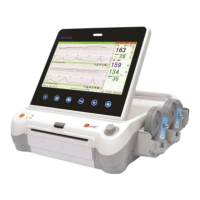S
S
S
R
R
R
F
F
F
6
6
6
1
1
1
8
8
8
B
B
B
6
6
6
U
U
U
s
s
s
e
e
e
r
r
r
’
’
’
s
s
s
M
M
M
a
a
a
n
n
n
u
u
u
a
a
a
l
l
l
~35~
Chapter 8 Fetal Monitoring
WARNING:
1) Always check if the alarm settings are appropriate for your patient before starting monitoring.
2) Check for any fault of the transducers before applying them to the patient.
3) Using a mixture of wired transducers and wireless transducers is not supported. When the monitor
is used on multiple pregnant women, you can only use wired US transducers and wired TOCO
transducers on one pregnant woman, and wireless US/TOCO transducers on the other pregnant
women.
CAUTION: When the monitor is used with HF surgical equipment, the transducer and the cables must be
avoided conductive connection to the HF equipment to protect against burns to the patient.
8.1 Confirming Fetal Life
Fetal monitoring with ultrasound can’t differentiate a fetal heart rate signal source from a maternal heart rate
source in all situations. These are some of the signal sources that might be taken as FHR signal source by
mistake:
- High maternal heart rate signal.
- Maternal aorta or other large vessels signals.
- Electrical impulse from the maternal heart transmitted through a recently deceased fetus.
- Movement of the deceased fetus during or following maternal movement.
So you need to confirm fetal life by other means before starting to use the fetal monitor, such as using a
fetoscope, stethoscope, Pinard stethoscope or obstetric ultrasonography.
8.2 Monitoring FHR with Ultrasound
The ultrasound monitoring is a method to obtain FHR on maternal abdominal wall. Place a US transducer
(Ultrasound transducer) on maternal abdomen. It transmits low energy ultrasound wave to the fetal heart, and
receives the echo signal.
8.2.1 Parts Required
US transducer
Aquasonic coupling gel
Belt
8.2.2 FHR Monitoring Procedure
1) Placing Transducer Belt
Place the transducer belts around the patient, ensuring that the belt will be around the abdomen
when it is fastened. Lay the patient on the bed.
Alternatively, the patient can take a sitting position. Arrange the belt around her abdomen.
2) Determining the Transducer Position
Determine the fetal position using Leopold’s maneuvers.
Search for the location of the fetal heart using a stethoscope or a fetoscope. The best fetal

